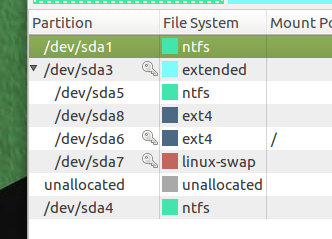On my disk I have 4 partitions as sub-partitions of sda3 (see screenshot). Is that normal? What did I do wrong?

Thanks for any help.
On my disk I have 4 partitions as sub-partitions of sda3 (see screenshot). Is that normal? What did I do wrong?

Thanks for any help.
You didn't do anything wrong.
It's the consequence of sda5,8,6,7 being 'logical' partitions I think.
Here's what it looks like on my machine:
Can I make one of these logical partitions a boot partition?
I'm pretty sure that you already have a boot partition ... here's another example [I labeled the partitions] This laptop had Windows 7 installed as default from Dell; I added Ubuntu.
This is perfectly normal. Your disk has a MBR partition table, which is limited to 4 primary partitions.
What is seen here is an extended partition, which counts as a primary partition but is actually a container for logical partitions.
As @ouroumov points out, they are logical partitions - you can have many of these (not sure on the exact limit). Ubuntu will happily boot from logical partitions (Windows won’t).
The other partition table is GPT, which doesn’t have these limitations. I think only Windows 8 and newer can boot from GPT partitions. Ubuntu is capable of booting from GPT partitions too. Although, only (U)EFI machines can boot GPT disks.
As many as there are available drive letters.
I’m not really sure of that because the drives letter depends on the OS while the partition tables don’t. They contain the information where are the partitions, so exceeding that number wouldn’t be write down on the partition table.
If I’m not wrong, I think it was 16 extended logical partitions.
That is not really true. I know there are lot of documents declaring that but they are wrong. Windows 7 can boot from a GPT disk but only after screwing the partition table and make itself think it is a MBR table, after that it will boot; I haven't tried with XP but obviously, this is a wrongly approach to take because you probably get a serious problem trying to recover your files after something went wrong.
On the other hand, if you put a GPT partition table on a drive with a non UEFI BIOS it will load it without problems.
This is an output from one of my machines with non UEFI BIOS after running sudo parted --list:
Tabla de particiones: gpt
Disk Flags:
Numero Inicio Fin Tamaño Sistema de archivos Nombre Banderas
1 1049kB 2097kB 1049kB bios_grub
2 2097kB 10,7GB 10,7GB ext2
3 10,7GB 14,5GB 3758MB linux-swap(v1)
4 14,5GB 122GB 107GB ext4
5 122GB 750GB 628GB ext4
[quote=“malwaredpc, post:7, topic:9637”]
If I’m not wrong, I think it was 16 extended logical partitions.
[/quote]A few years ago I was loading loads of distros on an added 2TB drive. You wouldn’t believe the grub boot list I had. 
On this MBR drive, sdb16 seemed to be the last one I could use. I could create sdb17 in GParted but couldn’t do anything with it (like putting a file system on it). Before anyone asks, sdb1,2,3 were primary and sdb4 was extended containing sdb5-16.
My 2 cents from a fun time.
All
Thanks so much. It is amazing how helpful you are.
I learnt a lot!
EXACTLY!!! The same!! I just didn’t remember if it was 16 or 64 the number. 16 then.
Yeah, I totally believe you!!! I used to do stuff like that, but now in a 32 thumb there’s not enough space.

I just forgot to mention. The limit for (primaries) partitions on GPT is 128 but you can change that number or decrease it by tweaking it.